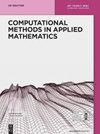HDG Method for Nonlinear Parabolic Integro-Differential Equations
IF 1.2
4区 数学
Q3 MATHEMATICS, APPLIED
引用次数: 0
Abstract
The hybridizable discontinuous Galerkin (HDG) method has been applied to a nonlinear parabolic integro-differential equation. The nonlinear functions are considered to be Lipschitz continuous to analyze uniform in time a priori bounds. An extended type Ritz–Volterra projection is introduced and used along with the HDG projection as an intermediate projection to achieve optimal order convergence of非线性抛物整微分方程的 HDG 方法
混合非连续伽勒金(HDG)方法被应用于非线性抛物线积分微分方程。非线性函数被认为是 Lipschitz 连续的,以分析时间上均匀的先验边界。当使用度数 k ≥ 0 k\geq 0 的多项式来逼近解和通量变量时,引入并使用扩展型 Ritz-Volterra 投影和 HDG 投影作为中间投影,以实现 O ( h k + 1 ) O(h^{k+1}) 的最优阶收敛。通过放宽非线性变量的假设,逐元素后处理可实现超收敛。利用时间方向上的后向欧拉法和正交规则对积分项进行离散化,得出了完全离散的方案及其误差估计。最后,在二维域数值实例的帮助下,获得了计算结果,验证了我们的结果。
本文章由计算机程序翻译,如有差异,请以英文原文为准。
求助全文
约1分钟内获得全文
求助全文
来源期刊

Computational Methods in Applied Mathematics
MATHEMATICS, APPLIED-
CiteScore
2.40
自引率
7.70%
发文量
54
期刊介绍:
The highly selective international mathematical journal Computational Methods in Applied Mathematics (CMAM) considers original mathematical contributions to computational methods and numerical analysis with applications mainly related to PDEs.
CMAM seeks to be interdisciplinary while retaining the common thread of numerical analysis, it is intended to be readily readable and meant for a wide circle of researchers in applied mathematics.
The journal is published by De Gruyter on behalf of the Institute of Mathematics of the National Academy of Science of Belarus.
 求助内容:
求助内容: 应助结果提醒方式:
应助结果提醒方式:


